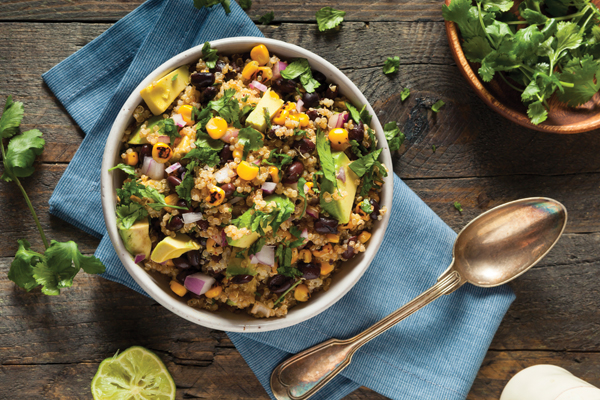How to be healthily gluten-free or vegetarian while expecting

Navigating the seemingly endless do’s and don’ts of pregnancy can […]
Navigating the seemingly endless do’s and don’ts of pregnancy can sometimes feel like a full-time job, right? No matter what you’re doing or where you’re going, there’s a constant nagging inside that nudges, Is that safe for my baby? Food is no different, and those daily decisions can be even more overwhelming when you’re on a modified diet.
If you’re watching your carbs because of gestational diabetes, eating gluten-free due to an allergy or intolerance, or simply skipping meat or dairy for personal reasons, we’ve got you covered. After chatting with a few experts, we’re giving you the lowdown on what you should know about common diet restrictions during pregnancy.
Going gluten-free
A gluten-free diet is the primary treatment for celiac disease, an autoimmune condition in which the body reacts to the gluten protein found in wheat, barley and rye by attacking the intestines. According to Alaina Strobel, RD, LD, CDE, at Texas Children’s Hospital Pavilion for Women in Houston, this results in gastrointestinal damage and malabsorption of key nutrients —which is why people with celiac disease are advised to avoid foods with gluten altogether.
Outside of celiac disease, going sans gluten has increased in popularity in part because some have touted its overall healthfulness—although the experts insist there are no extra health benefits to going gluten-free unless your body has shown a negative reaction to gluten.
If you’re pregnant and eating gluten- free, you should know that it’s absolutely possible to get the necessary nutrients
for you and baby from whole foods. Even though grocery stores continue to offer more gluten-free options, it’s best to opt for whole over processed foods when you’re able.
To ensure adequate intake of thiamin, riboflavin, niacin, folate and iron, Reut Bardach, MD, a board-certified OB/GYN at Obstetrics and Gynecology of Trinity, near Tampa, Florida, suggests pregnant women eat more fresh fruit. “Foods such as potatoes, rice, corn, nuts, beans, lentils, eggs and dairy can also be used to supplement the loss of nutrients from following a gluten-free diet,” she says.
To up your fiber and overall nutrient intake, Vandana Sheth, RDN, CDE, a spokesperson for the Academy of Nutrition and Dietetics, recommends focusing on naturally gluten-free whole grains such as brown rice, quinoa or amaranth instead of heavily processed gluten-free grain products, which are often stripped of key nutrients and fiber.
Intimidated by unfamiliar grains such as amaranth or millet? Many cook in a way that is similar to brown rice, and all freeze beautifully. (Check out Pinterest
for a plethora of easy recipes and cooking tutorials.) After you find a gluten-free grain—or two—you enjoy, whip up a large batch. Then freeze some in single-serving containers, and use the rest for this week’s dinners.
One meal Sheth loves for expectant mamas? Combination bowls. “Use some leftover quinoa, then add some chicken and stir fry vegetables, and you’ve got a quick and easy meal that’s giving you a good combination of vegetables, protein, and whole grains.” Swap a hard-boiled egg for chicken, or mix up the veggies for whatever you’re craving, and voila! Multiple meals at the ready.
Beating gestational diabetes
Did your doctor ask you to make certain diet changes to watch your carbohydrate content? That might be because you have gestational diabetes (GD)—and if so, you’re certainly not alone. According to the Centers for Disease Control and Prevention, gestational diabetes affects up to 9 percent of expectant women.
With GD, your pregnancy triggered the diabetes, and the condition will likely go away after you’ve given birth. Until then, your blood sugars run higher than normal, and if left unchecked, can lead to serious risks for both you and your baby.
“Babies born to women with uncontrolled diabetes tend to be larger, tend to have a large amount of amniotic fluid, and tend to have complications after birth, including an inability to regulate their own blood sugars,” says Bardach.
However, diet plays a huge role in GD blood sugar management, and thankfully there’s lots you can do to avoid those complications.
Rather than thinking of it as a restrictive diet, Bardach likes to refer to GD-specific eating as “a healthy eating plan that is rich in nutrients and low in fats, calories and carbohydrates.” What does that look like? Lots of fresh fruits, vegetables and whole grains. Instead of simple sugars in baked goods or processed foods, you should choose complex carbs such as oatmeal, brown rice and whole grain pastas.
“I will generally tell women, once diagnosed with gestational diabetes, that a great way to start this diet is to replace all ‘white foods’ with their brown alternatives,” she says. So ditch the white bread for whole wheat, white rice for brown, and russet potatoes for sweet potatoes.
Forgo the fruit juice or soda for some sparkling fruit-infused water, and you’re well on your way to a diabetes-friendly diet.
As Strobel points out, this way of eating is less about what to eat and more about how much. So get out your measuring cups because portion control reigns queen here, particularly when it comes to carbs (the main culprit in blood sugar spikes).
Just how many carbs you shoot for in any given meal will depend on multiple factors, so ask your doctor if you don’t already know those specifics. But in general, Sheth says most women with gestational diabetes can eat between 30 to 45 grams of carbohydrates per meal, and up to 15 grams of carbs per snack.
The more protein and veggies you load your plate with, the more satisfied you’re going to feel. When in doubt, always add a protein to your carbs. For example, snack on a piece of string cheese with that apple. According to Sheth, it’s that carb-protein combo that helps to blunt the rise in blood sugar.
Vegging out
Many people today follow a wide variety of vegetarian and vegan diets—from vegetarianism (which excludes red meat, poultry and seafood) to ovo-vegetarian, (which allows the consumption of eggs) to pescatarian (which includes fish but no meat or poultry). Veganism is the most restrictive, excluding all animal products, including meat, dairy, eggs and honey. Religious leanings, health goals or ethical considerations … the reasons someone might follow one of these diets are as varied as the restrictions themselves.
As far as pregnancy concerns go, all of these diets can be safe for mom and baby. The trick is in knowing which nutrients to pay extra attention to and ensuring you’re eating an array of whole foods to get those nutrients.
“Most vegetarian diets will meet most of the nutritional needs and goals for pregnant patients with the exception of iron, vitamin D, vitamin E and chloride,” says Bardach, who notes that focusing on plant-based proteins such as grains, legumes and nuts can provide the vitamins and minerals necessary for a healthy pregnancy.
Make sure you’re meeting your increased protein requirements (70 to 90 grams daily) by leaning on nuts, legumes, beans and quinoa. For calcium and vitamin D, look to orange juice, almonds and broccoli. Dark leafy green vegetables such as bok choy and collard greens are also high in calcium.
To up your iron intake, Strobel points to plant sources of iron (called non-heme sources), including grains, spinach and beans. They’re best absorbed when combined with a source of vitamin C, such as citrus or strawberries, she says. Conversely, “If you need to take an additional iron supplement, avoid eating calcium-containing foods at the same time because this inhibits absorption,” Strobel advises.
For vegans in particular, vitamin B12 and essential fatty acids are two of the biggest nutritional concerns. “Vitamin B12 is obtained from animal sources … so a supplement may be necessary,” says Bardach. Your prenatal vitamin should offer at least some of the vitamin B12 you need, and many foods these days are fortified with it as well. Check out the food labels on cereals, soy milks and other products to see how much you’re consuming.
Flaxseed, walnuts and soybeans can provide the necessary amounts of DHA, but you should talk to your doctor about microalgae supplements if you’re worried that you’re not getting enough from plant-based sources alone.
One great veggie-friendly meal idea for pregnant women: vegetarian chili. Full of beans, vegetables, spices and tomatoes (which enhance the iron absorption from the beans and lentils), it’s easily customizable to what you crave and what’s in season.
“Pour that on top of quinoa or brown rice,” says Sheth, “or eat it with a whole grain tortilla, and that’s a great nutritionally balanced meal.”
Meet your match
Pregnancy is the perfect time to make contact with a dietitian, according to Vandana Sheth, RDN, CDE. Whether you’re looking for input on a special diet or just want some healthy food tips or meal ideas, a professional can help ensure you’re getting the nutrients needed for you and baby.
“Pregnancy can be overwhelming, and special nutritional needs or restrictive diets can add to that,” she says. “A dietitian can help you with meal plans and snack ideas, and offer practical tips.”
In fact, Sheth recommends women check in with a nutrition expert even prior to getting pregnant, if they can. Because babies need certain nutrients, such as folate and iron, starting the day they’re conceived, why wait until your little bean is already growing to make sure the environment is just right?
Look up a dietitian near you at eatright.org. If you’re unsure about whether your insurance will cover such a visit, call or email your plan administrator to find out.







